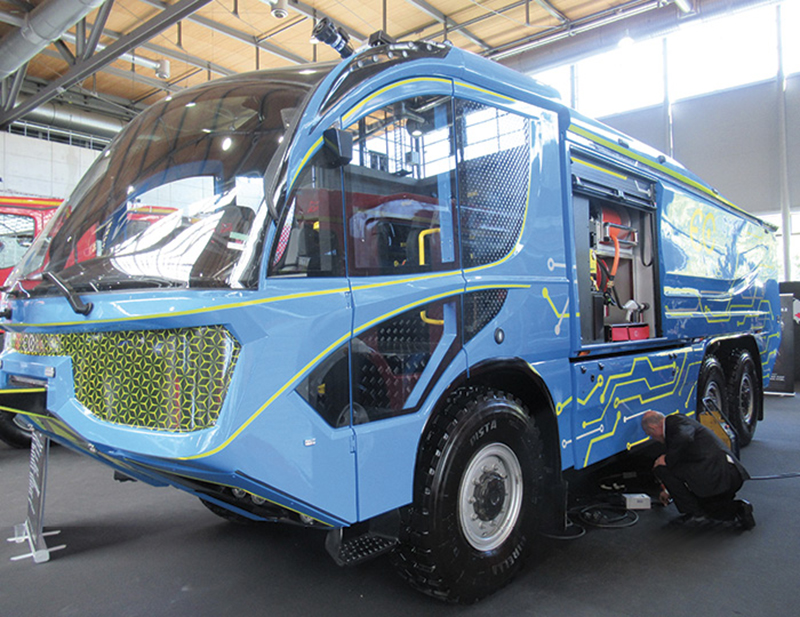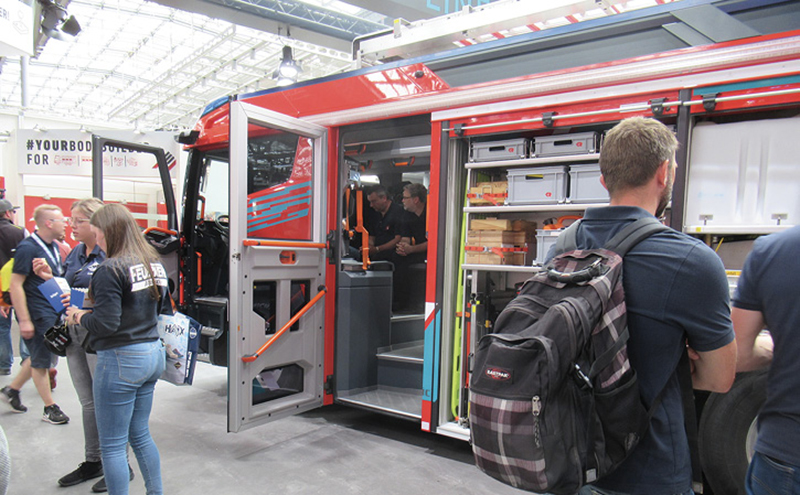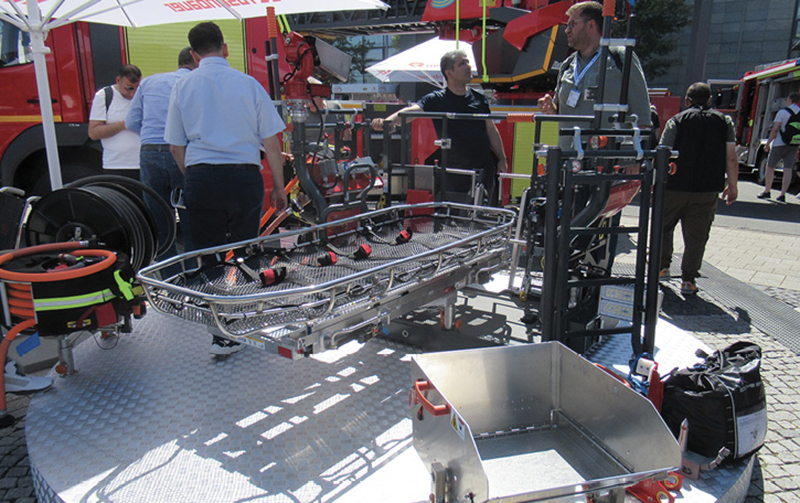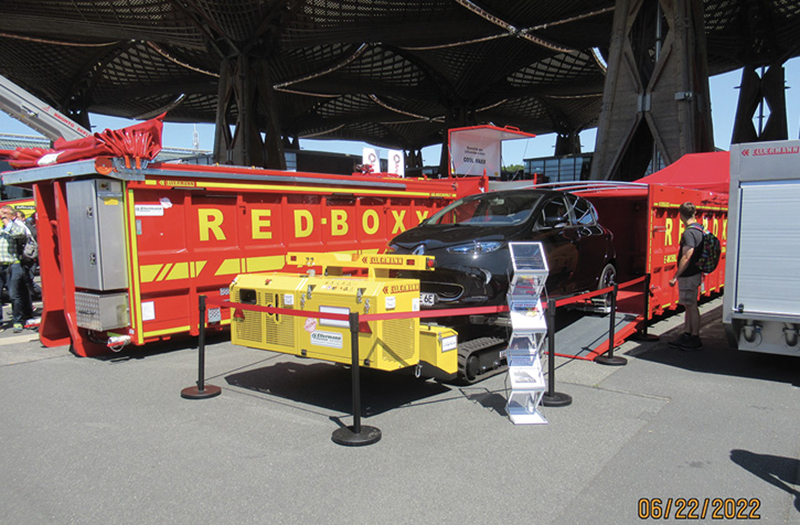
KEEPING IT SAFE Robert Tutterow

The number of apparatus on display at Interschutz this year was lower than in previous years. Nonetheless, there was a lot of new technology, designs, and product improvements on display.
The basic design of the European apparatus has not changed. For example, there is no hosebed, all compartment doors are roll-up, and the compartments are highly organized. The cabs sit high and entrance/egress is difficult, they are all painted red, and they all have yellow reflective striping. There were no U.S. apparatus on display. Not surprising was the abundance of electronics prevalent at all the pump panels, which are located at the rear of the apparatus.
By far, Rosenbauer had the largest presence of all the apparatus manufacturers. There were four electric-powered vehicles, including an ARFF unit and an aerial platform (photos 1 and 2). All were on a Volvo chassis. Some of the units had very spacious cabs and could be lowered while parked. This is a very safe design, especially when exiting the cab with personal protective equipment donned (photo 3).
- Interschutz 2015: a Platform for International Exposure
- Interschutz 2015 Fire Apparatus by Dave Stewardson
- Smeal Displays CORE Pumper at Interschutz 2015
- Allison Transmission to Showcase Products at Interschutz 2015

1 Rosenbauer had several electric-powered apparatus on display including an aerial. (Photos by author.)

2 Many of the trucks in the Rosenbauer booth were based on Volvo chassis.

3 Several trucks featured apparatus that could be lowered to create safer cab ingress and egress.
Another impressive display from Rosenbauer was a detached platform, which had all the platform accessories available that can be mounted on the platform, including a wheelchair and a two-person stokes basket (photo 4). All European aerial devices have the platform design; however, they do not all have piped waterways. The platform design is most impressive to this baby boomer, as many of us would much prefer to be rescued onto a platform rather than navigate down a “straight-stick” ladder.
The Jacinto Company displayed an electric aircraft rescue and firefighting unit that was designed to be unmanned. Supposedly the only one in the world, it contained five electric motors. One was for the pump and the other four were for traction on drive wheels. The unit was designed to pump for up to four hours and could be driven remotely for up to a kilometer away (just over a half-mile) (photo 4).

4 Rosenbauer displayed several attachments that could be fitted to its platform aerials.
This was the first show where I saw vehicles designed to remove electric cars that have been on fire or are on fire. The units were like big roll-off trash dumpsters typically found at construction sites and are used to contain vehicles until the threat of fire no longer exists.
Fire Isolator promoted several items: FR blankets that cover the car, like a salvage cover; an aerosol unit, like an oversized hockey puck to push under the car; a piercing nozzle for penetrating the battery; a thermal imager; and the “Dipping Container” (like the previously mentioned big dumpster). Water is added to the “Dipping Container” to keep the battery cool. The car is often left in the container of water for several days (photo 5).

5 One product that got a lot of attention was a containment unit used to extinguish electric vehicle fires. Burned or burning vehicles are placed in the containment unit, which is filled with water, and they are left submerged until the fire is completely extinguished.
Noteworthy nonapparatus equipment included several lighting manufacturers offering portable lights stands and an almost infinite number of hand lights from which to choose. Virtual training tools and software attracted a lot of attention, including the Australian-designed FLAIM system available through W.S. Darley in the United States.
One attention getter was a couple of floating aluminum bridges that could be folded, transported, and deployed to larger waterways. The bridges were designed to carry a full-size pumper.
The Magirus Company displayed several robots, called Alpha Robotics, designed for fire suppression applications. They were all on track-style platforms.
Finally, there was a portable hose cleaner on display built by the Barth Company, a German manufacturer. I mention the product because it was designed by a retired Philadelphia firefighter, Henry Costco, with help from Dr. Bryan Ormond of N.C. State University. The product should be available in the United States soon.
ROBERT TUTTEROW retired as safety coordinator for the Charlotte (NC) Fire Department and is a member of the Fire Apparatus & Emergency Equipment Editorial Advisory Board. His 44-year career includes 10 as a volunteer. He has been very active in the National Fire Protection Association through service on the Fire Service Section Executive Board and technical committees involved with safety, apparatus, and personal protective equipment. He is a founding member and president of the Fire Industry Education Resource Organization (F.I.E.R.O.).

